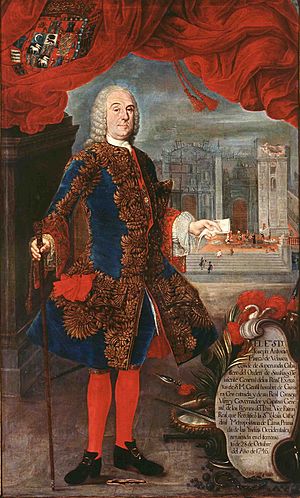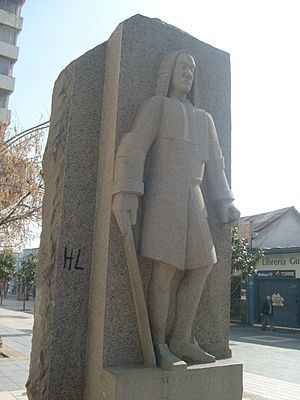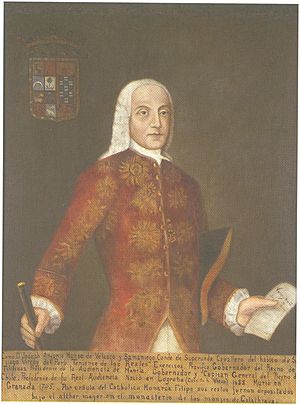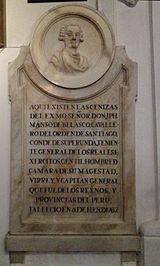José Manso de Velasco, 1st Count of Superunda facts for kids
José Antonio Manso de Velasco y Sánchez de Samaniego (born May 10, 1689 – died January 5, 1767) was an important Spanish soldier and politician. He held two very high positions in the Spanish colonies. First, he was the Governor of Chile. Later, he became the Viceroy of Peru.
Quick facts for kids
The Most Excellent
The Count of Superunda
|
|
|---|---|

Portrait of Manso de Velasco as Viceroy of Peru, 1746
|
|
| 30th Viceroy of Peru | |
| In office December 15, 1745 – October 12, 1761 |
|
| Monarch | Ferdinand VI |
| Prime Minister | Marquis of Ensenada |
| Preceded by | José Antonio de Mendoza |
| Succeeded by | Manuel de Amat |
| Royal Governor of Chile | |
| In office November 15, 1737 – June 1744 |
|
| Monarch | Philip V |
| Preceded by | Manuel de Salamanca |
| Succeeded by | Francisco José de Ovando |
| Personal details | |
| Born | May 10, 1689 Torrecilla en Cameros, Spain |
| Died | January 5, 1767 (aged 77) Priego de Córdoba, Spain |
| Children | Diego Manso de Velasco |
| Profession | Brigadier General |
Contents
Governor of Chile: Building and Peace
Manso de Velasco was the governor of Chile from November 1737 to June 1744. During his time, he started many important projects. He helped build the first public food market in Santiago. He also created irrigation canals for the Maipo River. These canals helped bring water to farms.
He also built breakwaters on the Mapocho River. These structures helped control the river's flow. He oversaw the rebuilding of Valdivia, a city damaged by an earthquake. He also made peace with the native Mapuche people. This peace agreement was called the "Parlement of Tapihue".
Founding New Cities
Manso de Velasco was also known for founding many new cities in Chile. Here are some of the cities he helped establish:
- Cauquenes (originally Nuestra Señora de las Mercedes), founded in 1742
- Copiapó (originally San Francisco de la Selva), founded in 1744
- Curicó (originally San José de Buena Vista), founded in 1743
- Melipilla (originally San José de Logroño), founded in 1742
- Rancagua (originally Santa Cruz de Triana), founded in 1743
- San Felipe, founded in 1740
- San Fernando (originally San Fernando de Tinguiririca), founded in 1742
- Talca (originally San Agustín de Talca), founded in 1742
Because he was so effective, King Ferdinand VI chose him for an even bigger job. In 1745, Manso de Velasco became the Viceroy of Peru. He was the first governor of Chile to be given such a high position.
Viceroy of Peru: A Time of Challenges

José Antonio Manso de Velasco served as the Viceroy of Peru from 1745 to October 1761. He was in charge during the reign of King Ferdinand VI. The most significant event during his time as viceroy was a huge earthquake in 1746.
The Great Lima Earthquake of 1746
On October 28, 1746, a massive earthquake hit Lima and the surrounding areas. It happened around 10:30 at night. This earthquake caused a very high number of deaths for the region. Some people said it lasted 3 minutes, others said 6 minutes. Today, experts believe it was a very strong earthquake.
The earthquake caused terrible damage in Lima. Out of 60,000 people, 1,141 died. Only 25 houses were left standing. In Callao, a huge tsunami followed the earthquake. The wave was almost 17 meters high. It traveled up to 5 kilometers inland. Only 200 people survived out of 5,000 in Callao. Many people were asleep when the earthquake hit, which led to more casualties. After the disaster, people faced hunger and fear.
Because of this earthquake, building methods changed. People stopped using adobe for houses. Instead, they started using a technique called quincha (wattle and daub). This method made buildings more flexible. These new structures were better at resisting strong earthquakes.
After the earthquake, Manso de Velasco helped rebuild. On February 10, 1747, he founded the city of Bellavista. He also started the construction of the cathedral of Lima on May 30, 1755.
Later Life and Legacy
After many years of service, Manso de Velasco was tired. He asked the king for permission to return to Spain and retire. The king agreed in 1761. On his way home, his ship stopped in Havana, Cuba. At that time, the British were attacking Havana.
Manso de Velasco, being the highest-ranking military officer there, was asked to lead the city's defense. He was 74 years old. The troops he commanded were not well-trained, and their equipment was old. After 67 days, the Spanish forces had to surrender.
The British captured him and took him to Cadiz in Spain. Because he had been in charge of the defense, he was later held responsible for the defeat. He was tried by a special court. The court decided that he and other leaders were responsible. King Charles III agreed with the court's decision in 1765.
Manso de Velasco was sentenced to live far from the royal court for 10 years. He also had to help pay for damages. Soon after, he went to live in Priego de Córdoba. He died there less than two years later, on January 5, 1767. His remains are still in the Church of San Pedro in that city.
See also
 In Spanish: José Antonio Manso de Velasco para niños
In Spanish: José Antonio Manso de Velasco para niños




